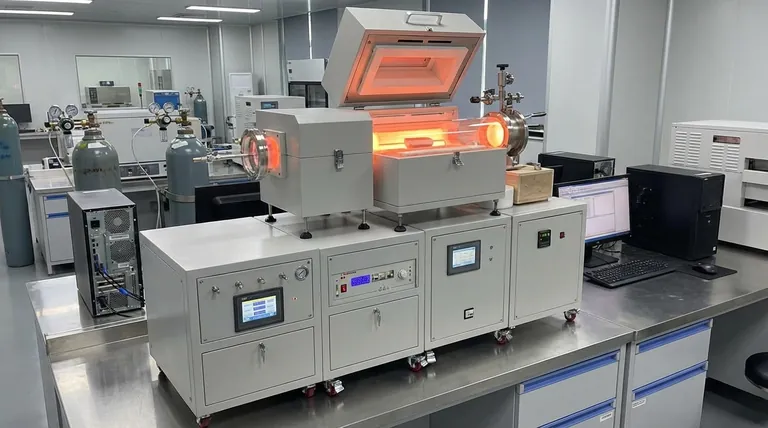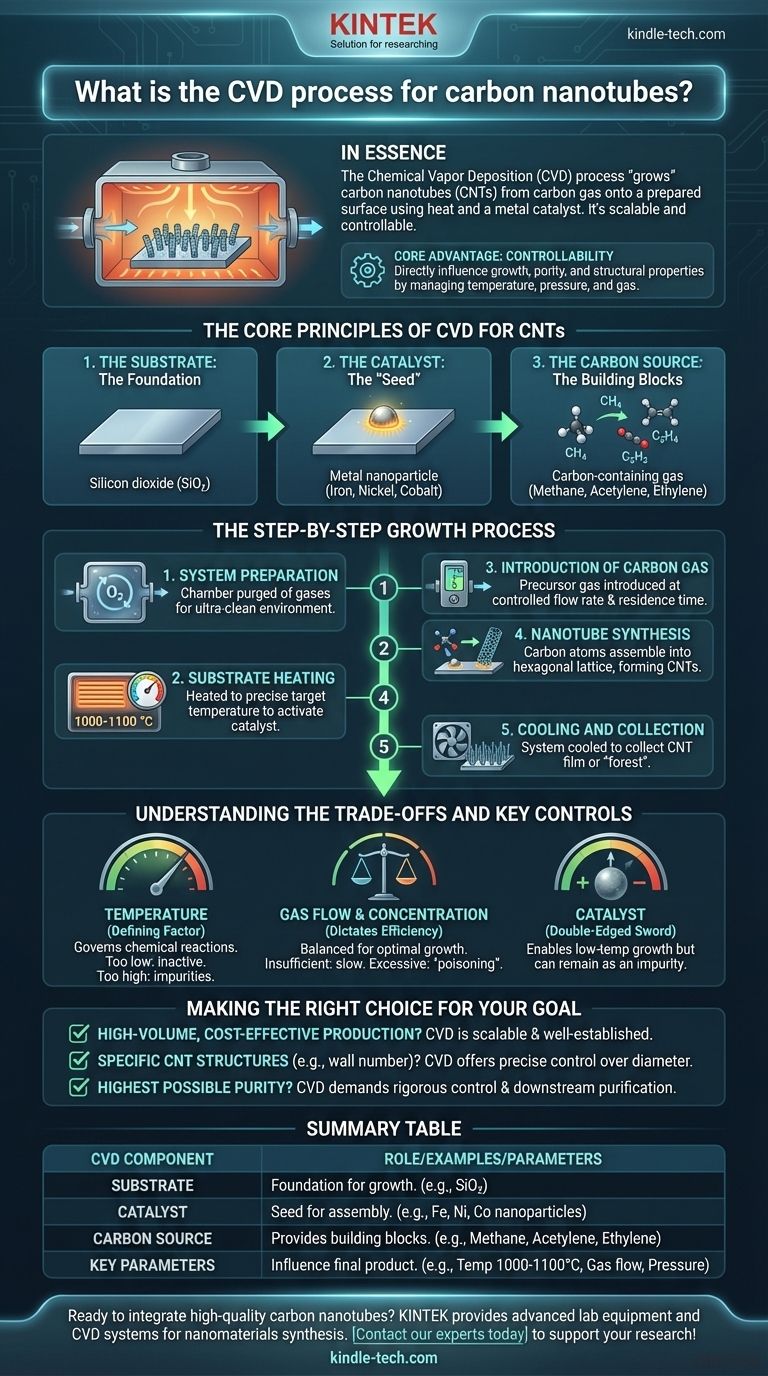In essence, the Chemical Vapor Deposition (CVD) process for carbon nanotubes (CNTs) is a method of "growing" them from a carbon-containing gas onto a prepared surface. This is achieved by using a hot, controlled environment and a metal catalyst, which acts as a seed for the nanotube structures to form and assemble. Unlike older methods, CVD is the dominant commercial process because it is scalable and allows for precise control over the final product.
The core advantage of CVD is its controllability. By precisely managing temperature, pressure, and gas composition, you can directly influence the growth, purity, and structural properties of the carbon nanotubes, making it the key technology for both industrial-scale production and advanced research.

The Core Principles of CVD for CNTs
To understand the CVD process, it's best to think of it as a highly controlled construction project at the nanoscale. Three key components are required: the substrate, the catalyst, and the carbon source.
The Substrate: The Foundation
The substrate is the base material upon which the carbon nanotubes will grow. Typically, a material like silicon dioxide is used.
This foundation is first placed in a reactor and heated to extreme temperatures, often between 1000-1100 °C. This step is critical for cleaning the surface and removing any impurities or passivation layers that could interfere with growth.
The Catalyst: The "Seed" for Growth
After the substrate is prepared, a thin layer of a metal catalyst is deposited onto its surface. This catalyst is the most important element for enabling CNT growth.
The catalyst, often a nanoparticle of a transition metal like iron, nickel, or cobalt, serves as a "seed." It breaks down the carbon source gas and provides a site where carbon atoms can assemble into the hexagonal lattice structure of a nanotube. Without it, the process would require impractically high temperatures.
The Carbon Source: The Building Blocks
The carbon source, or precursor, is a gas that contains carbon atoms. Common precursors include methane, acetylene, or ethylene.
This gas is fed into the hot reactor, where it flows over the catalyst-coated substrate. The high heat and the catalytic action cause the gas molecules to decompose, releasing the carbon atoms needed to build the nanotubes.
The Step-by-Step Growth Process
The synthesis of carbon nanotubes via CVD follows a clear, sequential path from a bare substrate to a final product.
1. System Preparation
The process begins in a sealed chamber or furnace. The chamber is purged of residual gases, especially oxygen, which can create defects and impurities. This ensures an ultra-clean environment.
2. Substrate Heating
The substrate is heated to a precise target temperature. This temperature is one of the most critical operating parameters, as it directly impacts the catalyst's activity and the resulting nanotube structure.
3. Introduction of Carbon Gas
Once the system is stable at the target temperature, the carbon precursor gas is introduced at a controlled flow rate. The concentration of this gas and the time it spends in the reactor (residence time) are carefully managed.
4. Nanotube Synthesis
At the hot, catalyst-coated surface, the precursor gas molecules break apart. The liberated carbon atoms dissolve into the catalyst nanoparticles, eventually precipitating out to form the cylindrical, tube-like structure of the CNTs.
5. Cooling and Collection
After the desired growth time, the carbon gas supply is shut off, and the system is carefully cooled. Controlled cooling is important to prevent thermal shock to the substrate. The result is a "forest" or film of carbon nanotubes covering the substrate.
Understanding the Trade-offs and Key Controls
While CVD is powerful, its success depends on meticulous control over its parameters. The interplay between these variables determines the final quality, yield, and cost of the CNTs.
Temperature is a Defining Factor
Temperature is not just about heat; it governs the chemical reactions. Too low, and the catalyst won't be active enough. Too high, and you may create amorphous carbon or other unwanted byproducts, reducing the purity of your nanotubes.
Gas Flow and Concentration Dictate Efficiency
The flow rate and concentration of the carbon source gas must be balanced. Insufficient gas will lead to slow or sparse growth, while excessive gas can "poison" the catalyst or lead to the formation of lower-quality, disordered carbon.
The Catalyst is a Double-Edged Sword
The catalyst is essential for enabling low-temperature growth, which is a major advantage of CVD. However, the catalyst material can remain as an impurity in the final CNT product, often requiring post-processing purification steps to remove it for high-purity applications.
Making the Right Choice for Your Goal
Applying CVD effectively requires aligning the process parameters with your desired outcome.
- If your primary focus is high-volume, cost-effective production: CVD is the definitive choice, as it is a scalable and well-established commercial process compared to alternatives like arc discharge or laser ablation.
- If your primary focus is creating specific CNT structures (e.g., single-walled vs. multi-walled): CVD offers the necessary control, as you can tune nanotube diameter and wall number by adjusting the catalyst particle size, temperature, and precursor gas.
- If your primary focus is achieving the highest possible purity: CVD can produce very pure materials, but it demands rigorous control over the environment and often necessitates a downstream purification strategy to remove catalyst residues.
Ultimately, mastering the CVD process is about understanding and controlling the fundamental relationship between your inputs and the nanomaterial you aim to create.
Summary Table:
| CVD Component | Role in CNT Growth | Common Examples |
|---|---|---|
| Substrate | Foundation for growth | Silicon dioxide (SiO₂) |
| Catalyst | Seed for nanotube assembly | Iron, Nickel, Cobalt nanoparticles |
| Carbon Source | Provides building blocks | Methane, Acetylene, Ethylene gas |
| Key Parameters | Influence on final product | Temperature (1000-1100°C), Gas flow, Pressure |
Ready to integrate high-quality carbon nanotubes into your research or production? KINTEK specializes in providing advanced lab equipment and consumables tailored for nanomaterials synthesis, including CVD systems. Our expertise ensures you achieve precise control over CNT growth for superior results in your laboratory. Contact our experts today to discuss how we can support your specific application needs!
Visual Guide

Related Products
- Chemical Vapor Deposition CVD Equipment System Chamber Slide PECVD Tube Furnace with Liquid Gasifier PECVD Machine
- Inclined Rotary Plasma Enhanced Chemical Vapor Deposition PECVD Equipment Tube Furnace Machine
- RF PECVD System Radio Frequency Plasma-Enhanced Chemical Vapor Deposition RF PECVD
- Customer Made Versatile CVD Tube Furnace Chemical Vapor Deposition Chamber System Equipment
- Split Chamber CVD Tube Furnace with Vacuum Station Chemical Vapor Deposition System Equipment Machine
People Also Ask
- What is the difference between CVD and PECVD? Choose the Right Thin-Film Deposition Method
- What is the difference between thermal CVD and PECVD? Choose the Right Thin-Film Deposition Method
- How are PECVD and CVD different? A Guide to Choosing the Right Thin-Film Deposition Process
- What are the examples of CVD method? Discover the Versatile Applications of Chemical Vapor Deposition
- What is the difference between CVD and PVD process? A Guide to Choosing the Right Coating Method



















